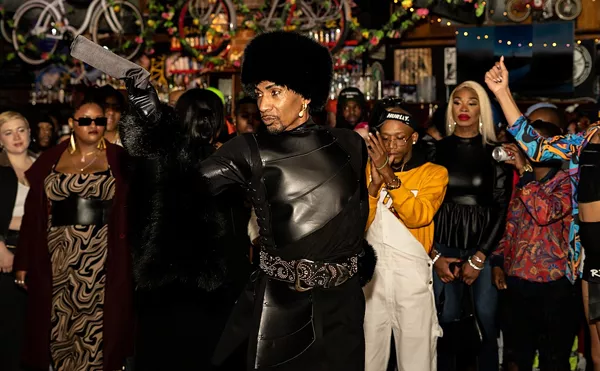That's all Elaine and Irv Waldmann want as they prepare to sell Carriage Bowl, the 24-lane bowling alley they've owned and operated since 1979. Irv is 65, Elaine 62. The bowling business has been slowing down for years at the busy intersection of Arsenal Street and Kingshighway, just across from Tower Grove Park.
Real-estate speculators had been stopping by to ask whether the Waldmanns were interested in selling, but Elaine didn't pay much attention at first. They always thought they'd sell to someone who would take over the bowling alley. Finally, Elaine says, a real-live "broker/developer" stopped in: "I laughed and said to him, 'What are you going to do, build a Walgreens?'"
At the time it was a joke, but jokes have a way of turning out to be true. Years ago, the Walgreens at Southwest Avenue and Kingshighway, less than a half-mile north of Carriage Bowl, was built where the old Palace Bowl had closed years before. In 1996, the Walgreens at Gravois and Hampton avenues replaced Red Bird Lanes, which at the time was still open. At one time Red Bird was open 24 hours a day, seven days a week.
So it goes that the Waldmanns are preparing to sell to Kaplan Real Estate Co., which in turn plans a building for the site that will be leased to Walgreens. With the imminent demise of Carriage Bowl, only one of the area's more than 40 bowling alleys will be located in the city. Aside from the church lanes at Epiphany and St. Mary Magdalen and the lanes at the International Bowling Hall of Fame downtown, the only alley in the city will be at Western Lanes, 4041 Bingham Ave.
The dynamics that interacted to close Carriage Bowl are factors familiar to anyone paying attention to urban reality: Population spirals outward to the suburbs and beyond, people want to recreate close to home, income levels in the city lag behind those in the county, bowling alleys are being swallowed up by larger corporations, Walgreens opens a store a day nationally, and, well, people drive wherever they go, and they want to park real close to where they're headed.
Listening to Irv and Elaine tell it, never mind all that demographic and macroeconomic stuff: Parking did them in.
"We can't park people, so it's killing our business," says Elaine. "We're landlocked."
The problems began, or got worse, back around 1985, when the Waldmanns tried to pave a vacant lot they owned behind the bowling alley. The lot faced Odell Street and was situated across from Holy Innocents Catholic Church. At night, bowlers had been parking at the gas station next door, but a new manager of the Shell station jacked up the fee he was charging the Waldmanns for parking privileges.
"He goosed it up so high, we thought, 'That's stupid.' He's sitting over there seeing dollar signs on us, and here we have a lot sitting back there vacant that we could do something with," says Elaine. "Our people wouldn't be walking that much farther, and it'd be well lit. They could come right in the back door -- what's the big deal? Why should we pay him when we got property we can do something with?"
But the parking-lot option wasn't to be. A few neighbors objected, and the neighborhood association came out against it. Ald. Robert Ruggeri (D-24th) went along with the crowd, and the necessary city permits were denied. Even the church got into it, with the pastor at the time opposing the parking lot and going so far as to hold a special Sunday-evening Mass, noting in the church bulletin that the association maintained that the parking lot would be "detrimental to the neighborhood." Elaine, who kept the April 18, 1985, church bulletin that announced the Mass, is still steamed that the priest got involved.
"I don't understand the whole thing with Holy Innocents," Elaine says. "They have no parking. We offered them that lot for funerals, weddings, Mass on Sunday. The times we knew we wouldn't be using it, they were more than welcome to use it. Why would you not want a parking lot?"
The parking controversy dragged on for several years, and at one point bowlers started to park on the unpaved lot. Irv was summoned to court.
"The judge told me if I didn't cable off the lot so no one could park there, he'd throw my ass in jail," Irv says. When Elaine corrects her husband by saying the judge used different terminology, Irv relents but adds, "He made it clear."
So the 30 or so parking spots on the west side of Carriage Bowl were all that were available to bowlers. Eventually, some patrons started to park up at the Schnucks store about a block away.
"When we were turned down for our parking lot, that next year we lost a third of our business, league-wise," says Elaine. The leagues that used the eight lanes downstairs left. Those leagues had an easier access through the back door to the parking lot in back. "When you have the house full and you have 24 teams, five on a team, that's 120 people. Most of the people bowling downstairs were older people, couples. They're not noisy people who are going to go out and make a big disturbance."
Once the leagues drifted off, revenues fell, and it became harder to keep up with modern bowling trends, such as the growing mania over bowling balls. Elaine recalls that Irv was a good bowler but never carried more than one bowling ball. Nowadays, when the Masters League comes to the Carriage Bowl once a year, the hotshot bowlers bring a variety of balls for a variety of conditions.
"They carry so many balls, they have them on a luggage thing on wheels, you know? They drag them around behind them," says Elaine. "The whole thing with bowling has changed."
On a recent Sunday, with only two lanes occupied, Irv agrees. Just to resurface one lane costs about $1,200, and it should be done about every three years. Irv, who once owned an auto-repair shop in Webster Groves and was a member of the Hoisting Engineers Local 513 for 15 years, would redo the lanes as best he could himself to save money. They also spent $52,000 in 1994 for an electronic scoring system. But it turned out to be a holding action, a losing battle against too many forces headed somewhere else.
"We had our worst summer. We opened three nights a week during the summer -- Friday, Saturday and Tuesday night. We had a little league on Tuesday night," says Elaine. "Nobody was coming in; you can't afford to have all that air conditioning. There were a couple of months where our air-conditioning bill was higher than what we brought in. This past summer was the killer; this summer was the wipe-out. We realized something had to be done."
Not that they didn't try just about everything. Students from St. Elizabeth Academy and the Career Academy across the street periodically used the lanes for physical-education classes. The Missouri School for the Blind was also a customer, and the Lions Clubs regularly brought in blind bowlers, who set up rails to help them navigate the lanes. Elaine says many of the blind bowlers are proficient.
"Some even sandbag it, keeping their average down so they get a better handicap," she says.
Renting the lanes out for parties was pursued, particularly the self-contained eight lanes downstairs. A nudist club rents out those lanes about two or three times a year. Elaine says they've been well behaved and no problem, and at first even kept a "drink runner" clothed to come upstairs to the bar for drinks. But then they started calling upstairs for drinks, and Elaine delivered them. The first time downstairs, she averted her eyes, but she had to look up to get paid. "He was sitting on the bench, naked as a jaybird," she says. "But he gave me a $5 tip."
But the occasional business from the blind, the nude and the student didn't make up for the fading of league play. In the midst of a grand societal shift, Carriage Bowl was merely at the crest of change. In his much-ballyhooed 1995 Journal of Democracy article, Harvard professor Robert Putnam pointed to the decline of league bowling as "the most whimsical yet discomfiting bit of evidence of social disengagement in contemporary America."
Between 1980 and 1993, the total number of U.S. bowlers increased by 10 percent, but league bowling decreased by 40 percent. For alley owners, this was bad news because league bowlers "consume three times as much beer and pizza as solo bowlers," Putnam wrote. "The broader social significance, however, lies in the social interaction and even occasionally civic conversations over beer and pizza that solo bowlers forgo."
Putnam theorized that such leagues increased "social capital," which leads to a "social connectedness," which in turn leads to "better schools, faster economic development, lower crime and more effective government." That may be the view from a Harvard ivory tower, but at Carriage Bowl this theory translates into fewer bowlers, an emptier bar and a snack bar open only two nights a week.
Despite all the mutations in bowling, Jim Baer, marketing director for the International Bowling Museum and Hall of Fame downtown, doesn't think the sport is in trouble.
"I don't think there's any scare going on in bowling at all," says Baer. "It's just that people have to be innovative and creative and use their old noodle a little bit. There's still 60 million bowlers in the world a year. There's a whole lot more people bowling than playing soccer or any other sport. There's strength in numbers. There's a lot more bowlers than golfers."
One bowler that will be a little more active is Irv, but it will be nothing like years ago, when he bowled in three leagues a week. He was a good bowler, though he was at a loss to explain his average.
"I averaged 190-200 on Sundays and 170-180 on Thursdays. I don't know why. Guess it had to do with the people you bowl with, how much you'd drink and other things," Irv recalls. "You know, bowling is the only sport you can drink while you do it. You can't do that with any other sport. Imagine drinking and playing basketball or football."
This time around, the Waldmanns, the Southwest Garden Neighborhood Association and Holy Innocents are all singing from the same hymnal. The main opposition to bulldozing Carriage Bowl and the adjacent vacant gas station is coming from Bob Shelli, a neighborhood resident, who collected close to 50 signatures opposing the project. But once word leaked out that the Walgreens would not have a liquor department and that it would close at 10 p.m., the tide seemed to turn in favor of the drugstore.
Shelli says the developer will be a "absentee landlord for an out-of-town corporation." He claims that a Walgreens at that location will "be an affront to the dignity of Tower Grove Park" and turn the corner into a "gaudy commercial hub."
Perhaps. But those with any sway -- the neighborhood association, the current alderman and the landowners themselves -- don't seem to be put off by the prospect. So instead of a place to bowl and increase "social capital," residents will have a drive-through pharmacy and a place to buy Chia Pets and last-minute Christmas gifts. And even with that, some neighbors expressed classic city pessimism when they approached Elaine after a recent meeting and wondered what would happen if the Walgreens failed and closed its doors.
"A few people came up to us and were worried that Walgreens wouldn't make it and they'd have to close the store," Elaine says. "At least you'd have a brand-new brick building sitting there -- it'd be easier to lease out.





